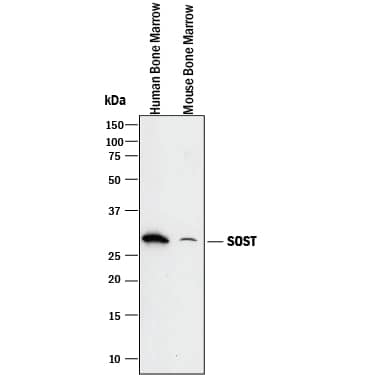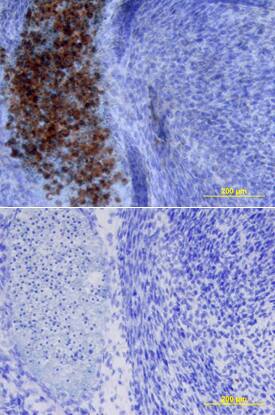SOST/Sclerostin Products
SOST, also known as Sclerostin, is a Cerberus/DAN family BMP antagonist and is an important regulator of bone homeostasis. Inactivating mutations in the SOST gene can cause sclerosteosis and van Buchem disease. SOST is expressed by terminally differentiated cells embedded in mineralized matrix including osteocytes, hypertrophic and prehypertroph...
216 results for "SOST/Sclerostin" in Products
216 results for "SOST/Sclerostin" in Products
SOST/Sclerostin Products
SOST, also known as Sclerostin, is a Cerberus/DAN family BMP antagonist and is an important regulator of bone homeostasis. Inactivating mutations in the SOST gene can cause sclerosteosis and van Buchem disease. SOST is expressed by terminally differentiated cells embedded in mineralized matrix including osteocytes, hypertrophic and prehypertroph...
| Reactivity: | Mouse |
| Details: | Goat IgG Polyclonal |
| Applications: | WB, IHC |
| Sensitivity: | 3.8 pg/mL |
| Applications: | ELISA |
| Assay Range: | 31.3 - 2,000 pg/mL (Cell Culture Supernates, Serum, EDTA Plasma, Heparin Plasma) |
| Source: | NS0 |
| Accession #: | Q9BQB4 |
| Applications: | BA |
| Sensitivity: | 4.17 pg/mL |
| Applications: | ELISA |
| Assay Range: | 15.6 - 1,000 pg/mL |
Recombinant Monoclonal Antibody
| Reactivity: | Human |
| Details: | Rabbit IgG Monoclonal Clone #2 |
| Applications: | ELISA |
| Reactivity: | Human |
| Details: | Mouse IgG2b Monoclonal Clone #220902 |
| Applications: | WB |
| Reactivity: | Mouse |
| Details: | Goat IgG Polyclonal |
| Applications: | WB, IHC |
Recombinant Monoclonal Antibody
| Reactivity: | Human |
| Details: | Human IgG2 Monoclonal |
| Applications: | ELISA, Flow, Func |
| Reactivity: | Human |
| Details: | Goat IgG Polyclonal |
| Applications: | WB |
| Source: | NS0 |
| Accession #: | NP_077769 |
| Applications: | BA |
| Assay Range: | 62.5 - 4,000 pg/mL |
| Applications: | ELISA |
| Reactivity: | Mouse |
| Details: | Rat IgG2b Monoclonal Clone #248121 |
| Applications: | WB |
| Reactivity: | Human |
| Details: | Goat IgG Polyclonal |
| Applications: | WB |
For use with catalog number DSST00
| Applications: | ELISA, Ctrl |
| Reactivity: | Human |
| Details: | Mouse IgG1 Monoclonal Clone #220910 |
| Source: | CHO |
| Accession #: | Q9BQB4.1 |
| Applications: | BA |
| Assay Range: | 31.2 - 2,000 pg/mL |
| Applications: | ELISA |
| Reactivity: | Mouse |
| Details: | Rat IgG2 Monoclonal Clone #RM0129-4D77 |
| Applications: | WB |
Recombinant Monoclonal Antibody
| Reactivity: | Human |
| Details: | Human IgG2 Monoclonal |
| Applications: | ELISA, Flow, Func |
Recombinant Monoclonal Antibody
| Reactivity: | Human |
| Details: | Human IgG4 Monoclonal |
| Applications: | ELISA, Flow, Func |
| Applications: | WB |
Recombinant Monoclonal Antibody
| Reactivity: | Human |
| Details: | Rabbit IgG Monoclonal Clone #2 |
| Applications: | ELISA |
Recombinant Monoclonal Antibody
| Reactivity: | Human |
| Details: | Human IgG4 Monoclonal |
| Applications: | ELISA, Flow, Func |
Recombinant Monoclonal Antibody
| Reactivity: | Human |
| Details: | Human IgG2 Monoclonal |
| Applications: | ELISA, Flow, Func |













![Western Blot: SOST/Sclerostin Antibody (RM0129-4D77)Azide and BSA Free [NBP1-22506] Western Blot: SOST/Sclerostin Antibody (RM0129-4D77)Azide and BSA Free [NBP1-22506]](https://resources.bio-techne.com/images/products/SOST-Sclerostin-Antibody-RM0129-4D77-Azide-and-BSA-Free-Western-Blot-NBP1-22506-img0001.jpg)
![Western Blot: SOST/Sclerostin Overexpression Lysate [NBL1-16341] Western Blot: SOST/Sclerostin Overexpression Lysate [NBL1-16341]](https://resources.bio-techne.com/images/products/Sclerostin-Overexpression-Lysate-Adult-Normal-Western-Blot-NBL1-16341-img0002.jpg)